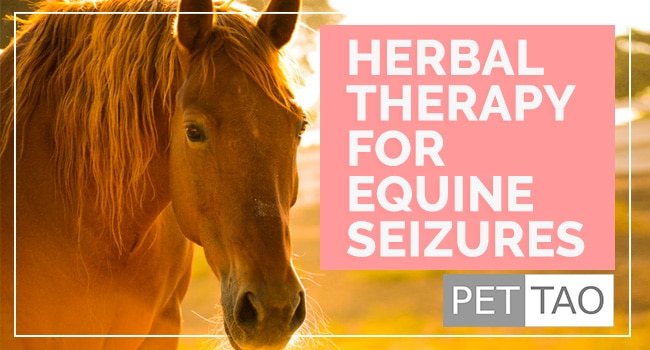Watching a beloved animal suffer from seizures is a terrible, frightening experience.
Unfortunately, equine seizures are a common experience and have many different causes.
Causes of Equine Seizures
Simplified, an equine seizure is a misfiring of brain signals.
Usually, after the seizure, the horse gradually returns to normal and standing within just a few minutes.
Some horses appear blind, dazed, or depressed for a few hours after having a seizure.
Sometimes a horse will have a seizure, then not have another for the rest of his/her life.
Other horses have seizures on a regular basis.
Equine seizures often occur secondary to other causes such as:
- Bacterial infections
- Brain trauma
- Encephalitis
- Liver or Kidney disease
- Low blood glucose
- Medication overdoses
- Metabolic disorders
- Oxygen deprivation (foals)
- Toxicity
- Tumors
Idiopathic epilepsy, displayed as recurrent seizures, is rare in horses.
Acquired epilepsy due to head trauma or brain inflammation usually appears several weeks after the illness or injury.
What Happens During Equine Seizures?
Horse seizure activity is displayed in several different ways.
Seizure activity includes:
- Abnormal chewing or licking
- Eyes rolling up
- Losing bladder and/or bowel control
- Losing consciousness for a short period of time
- Paddling legs
- Sudden collapse
- Sweating
- Twitching and jerking of muscles in the legs and body
- Twitching muscles around muzzle and jaw
Seizures may look painful, but in reality, horses are unconscious during the seizure and don’t feel anything.
Fortunately, horses do not suffer while having a seizure.
After the seizure, the horse may be disoriented and confused.
It might wander aimlessly around the pasture or pace.
Often, horses recover immediately after a seizure, though some horses may seem “off” for up to 24 hours.
How Di Tan Tang Helps Control Seizures in Horses
Some vets recommend pharmaceuticals to help control seizures in horses.
Often, though, holistic veterinarians and horse parents prefer to try something natural first.
Herbs provide a gentle, tonic alternative for many horses.
Most herbs don’t have side effects.
Di Tan Tang: Western Philosophy
Even though Di Tan Tang is an Eastern herbal blend, it still helps symptoms of some Western diagnoses.
Di Tan Tang helps horses suffering from:
- Convulsions
- Epilepsy
- Seizures
Di Tan Tang: Eastern Philosophy
Eastern medicine treats a disease’s root cause(s) rather than symptoms.
Accordingly, TCVM veterinarians evaluate equine seizures differently than Western veterinarians.
TCVM vets look for signs of imbalance.
Di Tan Tang helps horses with the following TCVM signs:
- Cough with yellow phlegm
- Fever
- Internal wind due to Wind-Phlegm with Heat
- Loss of consciousness
- Occasional constipation
- Red or purple tongue with a greasy coating
- Screaming while foaming at the mouth
- Slippery pulse
- Sudden seizures
- Wood personality (irritable or agitated)
How Di Tan Tang Helps Equine Seizures
Di Tan Tang is a TCVM blend of 13 different Eastern herbs.
The herbs perform synergistically, balancing systems and meridians in the body.
Di Tan Tang addresses the underlying causes of seizures in horses.
And, the underlying cause of any disease is always an imbalance somewhere in the body.
Di Tang Tang alleviates your horse’s imbalances while treating the symptoms of equine seizures.
According to Traditional Chinese Medicine, Di Tan Tang works by:
- Transforming phlegm
- Clearing internal wind
- Stopping seizures
What Are the Ingredients in Di Tan Tang?
The main ingredients in Di Tan Tang are:
- Chen Pi moves Qi and transforms phlegm
- Dan Nan Xing transforms phlegm
- Fu Ling drains damp
- Gan Cao harmonizes
- Gan Jiang harmonizes
- Gou Teng extinguishes internal wind and clears liver heat
- Hai Zao transforms phlegm, clears heat, and softens the hardness
- Kun Bu transforms phlegm, softens the hardness, and drains water
- Ren Shen (Kirin) tonifies Qi
- Si Jue Ming clears liver heat
- Shi Chang Pu opens the orifice and eliminates Damp
- Zhi Shi moves Qi
- Shu Ru transforms phlegm
Dr. Huisheng Xie, the founder of the Chi Institute in Reddick, FL, created Di Tan Tang specifically for animals.
Dr. Xie based Di Tan Tang on the ancient TCM formula from Ji Sheng Fang by Yan Yon-He, 1923.
Di Tan Tang works best when combined with plenty of water, Eastern Food Therapy, and moderate exercise.
Note: Information on this site is for educational purposes only and is not meant to substitute the advice provided by your own veterinarian.
Get Di Tan Tang TCVM Pet Supply








